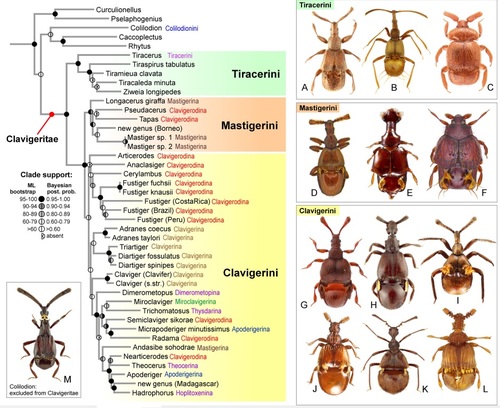本系費卡契助理教授解密喜蟻性隱翅蟲分類與地理起源

寡節蟻甲(Clavigeritae)是一群在蟻巢中的寄生性隱翅蟲(Staphylinidae),因為牠們的口器太小而無法獨自進食,所以牠們需要由螞蟻餵養才能生存。這也就是說,牠們的形態與生態反應了與螞蟻共同適應的結果。在演化的歷程中寡節蟻甲的不同類群會「跳進」新的螞蟻宿主並相應地調整形態。牠們與螞蟻之間的適應關係似乎是隨機的,所以造就了瘋狂的形態多樣性。這個研究團隊的成員來自自捷克、美國和日本,在分析了這些甲蟲的分子系統發育和形態演變後發現這些甲蟲與宿主螞蟻之間並沒有「忠誠的共同進化關係」。這些甲蟲似乎在演化的歷程中能使用任何在環境中可利用的螞蟻,所以若要能逃避螞蟻的攻擊,牠們必須是模仿螞蟻溝通的大師,所以才能長期愚弄許多在演化上關係很遠的螞蟻類群!
Clavigeritae beetles is a group of rove beetles (Staphylinidae) living as nest parasites of ants. They need to be fed by the ants to survive, as their own mouthparts are too reduced for independent feeding. The group is a diverse collection of weird but cool-looking creatures. It was supposed this is a consequence of co-evolution with ants: the beetle evolution mirrors that of the ants, and sometimes beetles "jump" to a new ant and adapt the morphology accordingly. Our team, consisting of researchers from the Czech Republic, USA and Japan, analyzed the molecular phylogeny and morphological evolution of these beetles. Surprisingly, we found out that these beetles do not co-diversify faithfully with their host ants. Instead, they seem to generate their crazy morphological diversity randomly (maybe as a consequence of their rarity and hence small populations). And they are highly promiscuous, trying to use any available ant to live with. To do so, they have to be masters at mimicking ant communication. The "best" beetle species can fool four unrelated genera of ants!
